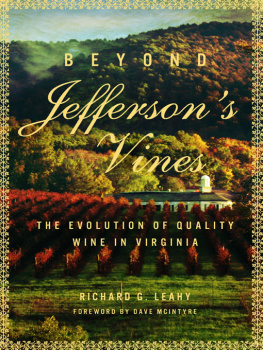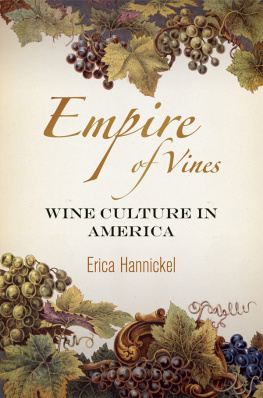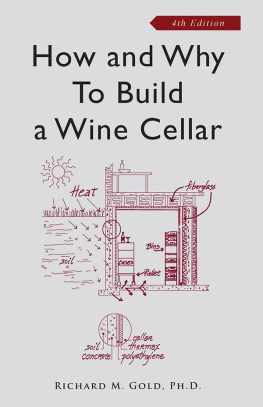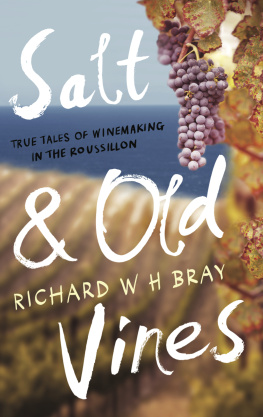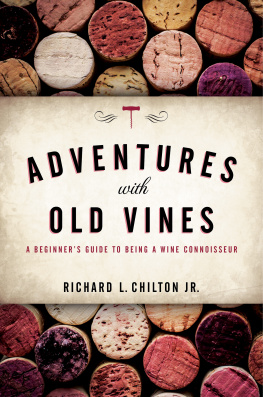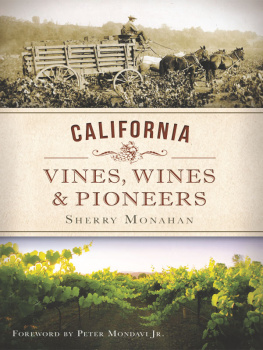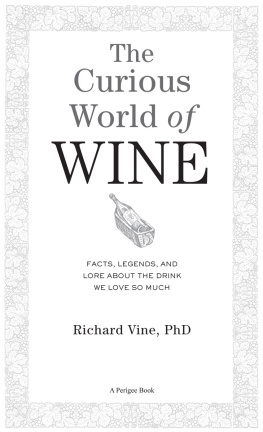Published by State University of New York Press, Albany
2014 Richard Figiel
All rights reserved
Printed in the United States of America
No part of this book may be used or reproduced in any manner whatsoever without written permission. No part of this book may be stored in a retrieval system or transmitted in any form or by any means including electronic, electrostatic, magnetic tape, mechanical, photocopying, recording, or otherwise without the prior permission in writing of the publisher.
Excelsior Editions is an imprint of State University of New York Press
For information, contact State University of New York Press, Albany, NY
www.sunypress.edu
Production by Jenn Bennett
Marketing by Fran Keneston
Library of Congress Cataloging-in-Publication Data
Figiel, Richard.
Circle of vines : the story of New York wine / Richard Figiel.
pages cm
Includes bibliographical references and index.
ISBN 978-1-4384-5380-4 (pbk. : alk. paper)
1. Wine and wine makingNew York (State)History. I. Title.
| TP557.5.N7F54 2014 |
| 338.4'7663209747dc23 | 2014002039 |
10 9 8 7 6 5 4 3 2 1
Preface
If this book had one starting point, it was in a seedy trailer on the shoulder of Bully Hill, January 1978. I spent much of that winter trimming vines for Heron Hill Vineyards, though I had no experience pruning grapevines. The closest Id come to vineyards was the sylvan pictures on the labels of bottles Id written about for a wine magazine in New York City. The owner of Heron Hill, Pete Johnstone, didnt seem to care. Just give them a haircut, he said. He had taken the same leap from city to Finger Lakes farm a decade earlier.
My workmate and roommate in the trailer, Vinnie Rizzo, had grown up on a fruit farm near Lake Ontario where his father grew grapes for the Taylor winery. Through a friend of Vinnies at Taylor, our woodstove had access to a seemingly endless supply of oak stickers emptying out of the old Pleasant Valley champagne cellars; these were the wood slats used over the past century to stack millions of sparkling wine bottles in tierage. The wood burned like fossil-coal, but there was an unsettling chill embedded in its heat: we were fueling our fire with fragments of Keuka Lake wines glorious past, at a time when things were falling apart. Coca-Cola had just acquired the Taylor Wine Company and the dismantling had begun.
At Heron Hill, instead of pruning the farms old Delaware vines we ripped them out to replant with Riesling. The wine Johnstone made from his final harvest of Delaware in 1977 would later earn a swan-song gold medal at the state fair. We burned those vines too.
As the vineyards lost all their leaves and their pruned branches that winter, so the entire New York wine industry appeared to be dying before it could regenerate. I bought an abandoned Catawba vineyard on the next lake to the east and, like Johnstone, began pulling out the past to plant the future. One day as I was lining up end-posts for the rows of my new vineyard (it was a matter of pride to get them perfectly aligned, row to row), my eye wandered beyond the last post into scrubby woods on the slope below, and there amid the junipers and brambles was a fitful row of weather-beaten posts, ghosts of a vineyard on that hillside that predated the vineyard Id pulled out to plant mine. I was looking back into the nineteenth century, and my posts happened to line up arrow-straight with that bleached, overgrown row of ghosts.
That sight probably made this book inevitable. I had latched onto the tail of a long story that needed to be explored and told. Part of the exploration involved a few decades of learning how to grow grapes on my Seneca farm, make wine from them, experiment with organic viticulture, wild-yeast fermentation, old ways of doing things.
In the research for this book I have depended, like Tennessee Williamss Blanche Dubois, on the kindness of strangers, as well as the generosity of friends. Some of the strangers have become friends in a shared enchantment with the past.
Members of the Underhill Society, especially Sarah and Robert Woody Underhill, were most helpful in retrieving the story of New Yorks first big vineyard at Croton Point. My thanks also to Marc Cheshire of the Friends of Croton Point, and Colleen Hughes at the Brotherhood winery.
In the Finger Lakes I am indebted to the candid insights of Fred Frank, to Gene Pierce, Carol and Jim Doolittle, Bruce Reisch and Alan Lakso at the Geneva Experiment Station, Kirk House and the diligent women volunteers of the Steuben County Historical Society, Rick Leisenring at the Glenn Curtiss Museum, Paul Sprague at the Greyton Taylor Wine Museum, Evan Fay Earles navigation through the archives of Cornells Kroch Library, and the generous swapping of notes by my colleague Thomas Pellechia. Special thanks to the administrator of Cornells Lee Library in Geneva, Mike Fordon, who threw himself into my project as if it were his own.
The surprising history of wineries on the western edge of the Finger Lakes has come to light largely through the efforts of Gary Cox and Jane Oakes at the Town of York Historical Society, backed up by the archival detective work of Cornell librarian Marty Schlabach. My thanks also to one-time O-Neh-Da winemaker John Cicero, and in Chautauqua County to historian John Slater and winegrowers Jennifer and Fred Johnson, Jr.
For their help with the inspiring story of Long Island wine, many thanks to Steve Mudd, Chris Baiz, Louisa Hargrave, Larry Perrine, Alice Wise at Cornells Riverhead research station, and Mariella Ostroski at the Cutchogue New Suffolk Free Library.
For all its ups and downs, the story of New York wine has barely begun; in the millennial time-scale of winemaking, this region is still in the nursery. To create a snapshot of how this state has plowed into the twenty-first century, many other people unnamed above have also contributed, not least my wife Deborah Pfautsch who, after years enduring my harangues about this project, still volunteered to go through it all again, producing the index.
Trumansburg, 2013
CHAPTER 1
Prehistory
About 10,000 years ago the wall of ice departed northern New York. It left behind a landscape that quickly came back to life. Fast-growing plants like grapevines were early colonizers; wild grapes repopulated nearly every corner of the state. The prospects for commercial viticulture would be another matter.
On the North Fork of Long Island some vineyards wash against a line of bluffs that hold back Long Island Sound and the ocean. When tractors till vine rows skirting those bluffs, their discs may stir up cobbles of granite that by all rights belong on 2,000-foot Berkshire mountaintops, 100 miles away.
Along the slopes rimming the Finger Lakes, growers also run discs through vineyards, sometimes peeling up scrims of shale imprinted with the shapes of ocean creaturesscallop shells, trilobites, brachiopods, sometimes fragments of the shells themselves200 miles from the sea. Grape-growing pioneers in the Thousand Islands district of the St. Lawrence River Valley and on Lake Champlain might keep an eye out for shards of whale bone.




